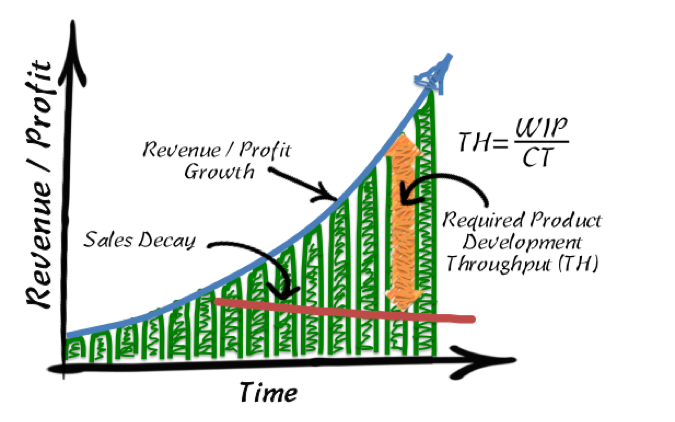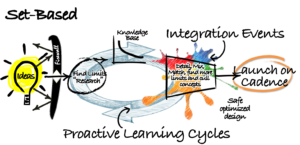Framework for Improvement of Business through Lean Product Development

Match Throughput to Business Need
Any work related to the improvement of business must be grounded in the fundamental purpose of the business – Revenue and Profit. A business should have objectives for revenue and profit growth which must match the capability of the product development system necessary to deliver both the Revenue and Profit objectives. For an existing business, there will be a natural decay of sales for products in the market. There are factors which can mitigate the sales decay, such as sales incentives. expanded geography and market reach, etc. In essence, however, doing nothing to existing products will lead to sales decay. The fiscal difference between the Sales Decay curve and the Revenue / Profit curve must be filled with new products and services. Filling this gap is the responsibility of the organization’s Product Development system.
In this case, Product Development refers to the organization’s strategy for the business, the portfolio plan encompassing both the product and technology roadmaps, engineering, product design, project management, sales, marketing, and any development aspects necessary to launch and bring a product to market. Little’s law identifies the product development throughput necessary to match product development with the business needs.

Where WIP is the Work in Process, TH is the Throughput, and CT is the Cycle Time.
Thus the throughput (TH) which the product development system must deliver is the number and type of projects needed to close the gap between the sales decay and the revenue / profit objectives. Effective management of the product plan (WIP) and the time-to-market (CT) dictate the throughput a development system will produce and in turn the revenue and profit of the business.
Questions to Consider:
-
What is the organization’s Revenue plan / Profit plan?
-
What has the organization delivered historically?
-
What is the sales decay of products?
-
What type of incentives does the organization use to address sales decay?
-
What is the organization’s product cadence?
-
How many and what type of products / projects does the organization deliver per unit time?
-
How does the organization designate projects / products?
-
What has the lift (revenue & profit impact) been for projects historically and how has that compared to objectives by type of project?
-
How many projects does the organization work on at any given time (WIP)?
-
What is the time-to-market (CT) for projects currently?
-
What is the product plan?
-
What is the technology roadmap?
-
How do the product plan and technology roadmap intersect?

